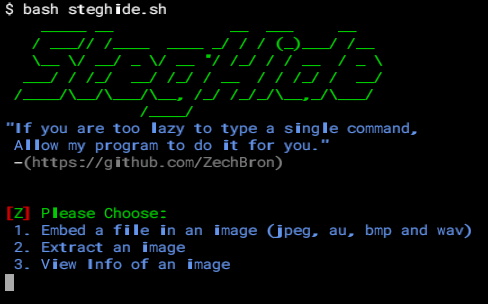
What is Steganography?
Steganography is the practice of concealing one piece of information within another to hide the existence of the secret information. It is often used in the context of digital data, where a hidden message or file is embedded within another file (such as an image, audio, video, or text) in a way that is not readily apparent to an observer. The goal of steganography is to ensure that the presence of the hidden information is difficult to detect. Tools like Steghide can be used for this purpose.
Here are some key points about steganography:
Concealment:
Steganography focuses on hiding information rather than encrypting it. The primary goal is to make the hidden data blend seamlessly with the cover data, so that it is not noticeable.
Cover Medium:
The cover medium is the carrier in which the hidden information is concealed. This can be an image, audio file, video, text document, or any other digital medium.
Hidden Data:
The information that is to be concealed within the cover medium is referred to as the hidden data or payload.
Techniques:
There are various techniques for steganography, including:
Least Significant Bit (LSB): This is one of the simplest methods, where the least significant bits of the cover data are altered to encode the hidden information. For example, in an image, the color values of certain pixels may be changed to encode binary data.
Spread Spectrum: This technique spreads the hidden data across the cover data in a way that is difficult to detect. It’s similar to how signals are spread across a broad frequency range in telecommunications.
Frequency Domain Techniques: These methods manipulate the frequency components of a signal, making it challenging to detect changes. They are commonly used in audio steganography.
Text Steganography: This involves hiding text within other text, often by using synonyms or other linguistic techniques to obscure the hidden message.
Applications:
Steganography has various applications, both legitimate and malicious. Some legitimate uses include watermarking images, protecting sensitive information, and ensuring data integrity. On the darker side, it can be used for covert communication, digital piracy, and cybercrime.
Detection:
Detecting steganography can be challenging, as the alterations made to the cover data are often subtle. Specialized software tools and algorithms are used to analyze files for signs of steganographic content.
Legal and Ethical Considerations:
The use of steganography for unlawful purposes, such as hiding malware or engaging in cyberattacks, is illegal and unethical. However, the technology itself is not inherently illegal and has legitimate uses.

What is Steghide?
Steghide is a popular open-source command-line tool used for steganography, specifically for hiding data within image and audio files. It’s a versatile and easy-to-use program that allows users to embed and extract secret messages or files from digital media while maintaining the integrity of the cover medium. Here are some key points about Steghide:
Functionality:
Steghide is primarily used for embedding and extracting data within image (JPEG) and audio (WAV) files. It supports a variety of encryption algorithms to protect the hidden data.
Usage:
Users interact with Steghide through the command line by providing various commands and options to specify the operation they want to perform. Common commands include embedding, extracting, and verifying data.
Embedding:
To hide data within an image or audio file using Steghide, you would typically use the steghide embed command. You provide the cover file, the file you want to hide, and an optional passphrase for encryption. Steghide will embed the data in the cover file.
Extraction:
To retrieve hidden data from a file, you would use the steghide extract command, providing the cover file and the passphrase (if encryption was used during embedding). Steghide will then extract the hidden data.
Encryption:
Steghide allows you to encrypt the hidden data with a passphrase, providing an additional layer of security. The same passphrase is needed to extract the data from the cover file.
Compression:
Steghide can also compress the hidden data before embedding it, reducing the size of the resulting file. This can be useful when embedding large files within images, for example.
File Format Support:
While Steghide is commonly associated with JPEG images and WAV audio files, it can work with other formats as long as they are converted to these formats beforehand.
Passphrase Security:
The passphrase is crucial in ensuring the security of the hidden data. If you forget the passphrase, you will not be able to extract the data from the cover file.
Platform Compatibility:
Steghide is available for various operating systems, including Linux, Windows, and macOS.
Legal and Ethical Considerations:
As with any steganographic tool, the use of Steghide has both legitimate and potentially malicious applications. While Steghide itself is not illegal, using it to hide data for unlawful purposes, such as unauthorized data transfer or copyright infringement, is illegal and unethical.
Installing Steghide:
Steghide comes installed within Kali but if you’re running a different Linux Distro you can install it with the following command:
sudo apt install steghide
How to use Steghide:
Steghide is a command-line tool with various commands and options for embedding and extracting data from cover files. Here are the basic commands you can use with Steghide:
Embed Data:
steghide embed -ef [embedding file] -cf [cover file] -sf [stego file] -p [passphrase]-ef [embedding file]: Specifies the file you want to hide.-cf [cover file]: Specifies the image or audio file where you want to hide the data.-sf [stego file]: Specifies the name of the resulting stego file.-p [passphrase]: Optional. Provides a passphrase for encrypting the hidden data.
Extract Data:
steghide extract -sf [stego file] -p [passphrase]-sf [stego file]: Specifies the stego file from which you want to extract data.-p [passphrase]: Optional. If you used a passphrase during embedding, provide it here.
Check a Stego File:
steghide info -sf [stego file]-sf [stego file]: Specifies the stego file you want to check. This command provides information about the file, such as the embedding file’s size and encryption status.
Version Information:
steghide version: Displays the version information of the Steghide tool.
Additional Commands:
steghide encinfo: Provides information about the available encryption algorithms.steghide --helporsteghide -h: Displays the help menu, which lists all available options and commands.
Conclusion
In summary, steganography is the practice of hiding information within other data to obscure its existence. While it has legitimate applications, it can also be used for malicious purposes, making it an area of interest and concern in the fields of cybersecurity and digital forensics. Steghide is a useful tool for those interested in steganography, whether for legitimate purposes such as protecting sensitive data or simply exploring the field of information security. However, it should be used responsibly and in accordance with applicable laws and ethical guidelines.
Happy Hacking Folks!
Ethical Hacking Guides
We have many guides to help you on your journey into the world of Ethical Hacking. If this is something you find interesting, please take a look here today: Ethical Hacking Guides.
Recommendation:
ALFA Network Wi-Fi Adapter: https://amzn.to/3QbZ6AE
This Wi-Fi adapter is essential if you are to learn Wi-Fi Hacking.





